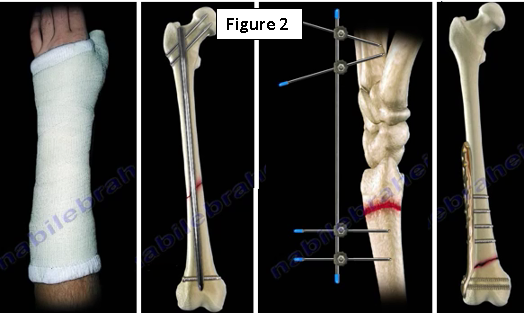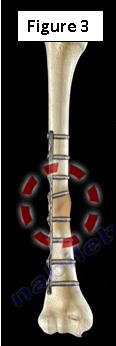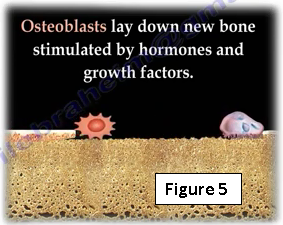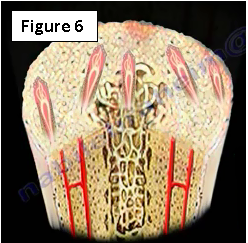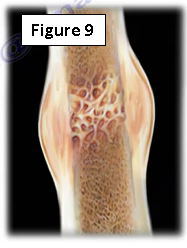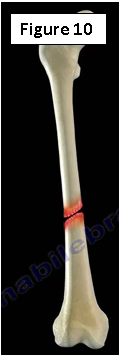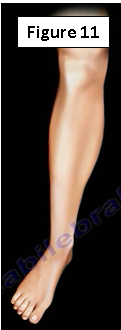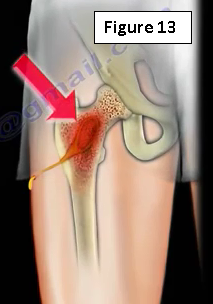Fracture healing is a process in which the body heals and repairs the broken bone.
Requirements for bone healing
A requirement for bone healing is vascularity (sufficient blood supply). The nutrient artery supplies 80% of the cortex. The periosteal vessels supply the outer 20% of the cortex. The metaphyseal vessels provide a very rich blood supply to the ends of the bone (Figure 1). Fractures stimulate the release of growth factors that attract stem cells and promote angiogenesis, vasodilation and healing of the bone. Blood flow increases at the fracture site. Metaphyseal bone heals faster than diaphyseal bone because of the rich blood supply.
A second requirement for bone healing is to have adequate mechanical stability of the fracture. This can be achieved with a variety of techniques including casting, rod placement, external fixator application, and plates and screws (Figure 2). Adequate stability promotes revascularization. Proper stabilization is needed to prevent deformity and non-union at the fracture site. Excessive motion will interrupt the development of new bone and may cause nonunion of the fracture.
Mechanism of Bone Healing
Primary bone healing is also called the cutting cone mechanism. There is no motion at the fracture site. This is seen in rigid fixation of fracture, such as in plate fixation, and there is minimal callus formation (Figure 3). Plates are usually used for humerus and forearm bone fractures and fractures involving the joint.
Cutting Cone Mechanism
Osteoclasts at the front of the lines of the cells eat up and remove the dead bone that results from trauma by dissolution through their powerful enzyme systems. Osteoblasts, when stimulated by hormones and growth factors, lay down new bone (Figure 5).
The cutting cones that are formed cross the fracture site. This is a slow process, often taking months to years to complete (Figure 6). Contact between the fracture ends allows healing to begin immediately. Larger gaps do not heal very well, as they could be filled with fibrous tissue.
Secondary bone healing is called the endochondral mechanism or endochondral ossification. It is seen in flexible fixation of fractures such as fractures stabilized by rods and casts (Figure 7). It occurs with abundant callus, which is seen on x-rays. Chrondocytes hypertrophy and degenerates then calcify followed by vascular invasion and ossification.
There are five stages of fracture healing (Figure 8):
1. Hematoma
2. Inflammation
3. Soft Callus
4. Hard Callus = Woven Bone
5. Remodeling
Remodeling is a process by which immature or woven bone is converted to mature or lamellar bone (Figure 9). The medullary cavity is reconstituted and bone is restructured in response to stress. There is more remodeling potential in children.
Complications of Fracture Healing
There are different complications that can be associated with fracture healing. There may be possible deformities at the fracture site.
Fracture shortening may also occur. Some shortening may be acceptable. Excessive shortening may need to be corrected.
A possible complication is a fracture nonunion, which is when the bone completely fails to heal after a reasonable period of time (Figure 10). The fracture area remains tender and painful, especially when the fracture is stressed, moved, or when the patient walks.
Another complication is a valgus deformity (Figure 11). A valgus deformity takes place when the distal part of a limb deviates away from the center of the body.
A varus deformity may also occur (Figure 12). This occurs when the distal part of a limb deviates towards the center of the body.
Osteomyelitis may also be a complication of fracture healing (Figure 13). Infection of the bone can occur, especially if there is an open fracture or when the fracture is opened to be fixed. Timely antibiotics in open fractures and preoperative prophylaxis antibiotics are important.
Physicians should be aware of these basic concepts of fracture healing. Every attempt should be made to avoid complications.
For more information on fractures, follow the links below:
https://www.youtube.com/watch?v=w9tWsEzsPkk
https://www.youtube.com/watch?v=Dn6mrXZLBjk
https://www.youtube.com/watch?v=21plYYmaxi8
https://www.youtube.com/watch?v=GPqe09FyPMU
For more information, visit my YouTube Channel:
https://www.youtube.com/user/nabilebraheim

